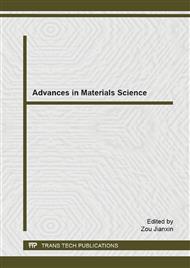[1]
Montheard JP, Chatzopoulos M, Chappard D. 2-hydroxyethylmethacrylate HEMA; chemical properties and applications in biomedical fields. J Macromol Sci Macromol Rev 1992; 32: 1–34.
DOI: 10.1080/15321799208018377
Google Scholar
[2]
Filmon R, Grizon F, Baslie MF, Chappard D. Effects of negatively charged groups (carboxymethyl) on the calcification of poly(2-hydroxyethylmethacrylate). Biomaterials 2002; 23: 3053–9.
DOI: 10.1016/s0142-9612(02)00069-8
Google Scholar
[3]
Davis PA, Huang SJ, Nicolais L, Ambrosio L. Modified PHEMA Hydrogels. In: Szycher M, editor. High performance biomaterials. Lancaster, PA, USA: Technonic; 1991. p.343.
DOI: 10.1201/9780203752029-22
Google Scholar
[4]
Kabra B, Gehrke SH, Hwang ST, Ritschel W. Modification of the dynamic swelling behaviour of pHEMA. J Appl Polym Sci 1991; 42: 2409–16.
DOI: 10.1002/app.1991.070420906
Google Scholar
[5]
Apicella A, Cappello B, Del Nobile MA, La Rotonda MI, Mensitieri G, Nicolais L. Poly(ethylene oxide) (PEO) and different molecular weight PEO's blends monolithic devices for drug release. Biomaterials 1993; 142: 83–90.
DOI: 10.1016/0142-9612(93)90215-n
Google Scholar
[6]
Peluso G, Petillo O, Anderson JM, Ambrosio M, Nicolais L, Melone MAB, Eschbach FO, Huang SJ. The differential effects of poly(2-hydroxyethylmethacrylate) and poly(2-hydroxyethylmethacrylate)/poly(caprolactone) polymers on cell proliferation and collagen synthesis by human lung fibroblasts. J Biomed Mater Res 1997; 34: 327–36.
DOI: 10.1002/(sici)1097-4636(19970305)34:3<327::aid-jbm7>3.0.co;2-m
Google Scholar
[7]
Schiraldi C, D, ' Agostino A, Oliva A, Flamma F, De Rosa A, Apicella A, Aversa R, De Rosa M (2004).
DOI: 10.1016/j.biomaterials.2003.10.059
Google Scholar
[8]
Aversa R, Apicella D, Perillo L, Sorrentino R, Zarone F, Ferrari F, Apicella A (2009).
Google Scholar
[9]
Sorrentino R, Aversa R, Ferro V, Auriemma T, Zarone F, Ferrari M, Apicella A. Three-dimensional finite element analysis of strain and stress distributions in endodontically treated maxillary central incisors restored with different post, core and crown materials. Dent Mater 2007; 23: 983–93.
DOI: 10.1016/j.dental.2006.08.006
Google Scholar
[10]
Frost HM. Structural adaptations to mechanical usage (SATMU). 1. Redifining Wolff's law: the bone modelling problem. Anat Rec 1990; 226: 403–13.
DOI: 10.1002/ar.1092260402
Google Scholar
[11]
Frost HM. Structural adaptations to mechanical usage (SATMU). 2. Redifining Wolff's law: the bone remodelling problem. Anat Rec 1990; 226: 414–22.
DOI: 10.1002/ar.1092260403
Google Scholar
[12]
Wolff J. Das Gesetz der Transformation der Knochen. Berlin: A Hirschwald; 1892.
Google Scholar
[13]
Frost HM. Mathematical elements of lamellar bone remodeling. Springfield: Charles C Thomas; 1964. p.22–25.
Google Scholar
[14]
Frost HM. A 2003 update of bone physiology and Wolff's law for clinicians. Angle Orthod 2004; 74: 3–15.
Google Scholar
[15]
Frost HM. Wolff's law and bone's structural adaptations to mechanical usage: an overview for clinicians. Angle Orthod 1994; 64: 175–88.
Google Scholar
[16]
Apicella A, Hopfenberg Hb. Water-Swelling Behavior Of An Ethylene-Vinyl Alcohol Copolymer In The Presence Of Sorbed Sodium Chloride. Journal Of Applied Polymer Science, 1982; Vol. 27(4), P. 1139-1148, Issn: 0021-8995.
DOI: 10.1002/app.1982.070270404
Google Scholar
[17]
Nicolais L, Apicella A, De Notaristefano C. Time-Temperature Superposition Of N-Hexane Sorption In Polystyrene. Journal Of Membrane Science, 1984; Vol. 18, P. 187-196, Issn: 0376-7388.
DOI: 10.1016/s0376-7388(00)85033-4
Google Scholar
[18]
Schwartz-Dabney, C.L. & Dechow, P.C. (2003) Variation in Cortical Material Properties Throughout the Human Dentate Mandible. American Journal of Physical Anthropology 120: 252-277.
DOI: 10.1002/ajpa.10121
Google Scholar
[19]
J Töyräsa, T Lyyra-Laitinena, M Niinimäkib, R Lindgrenc, M. T Nieminenb, I Kivirantad, J. S Jurvelina, Estimation of the Young's modulus of articular cartilage using an arthroscopic indentation instrument and ultrasonic measurement of tissue thickness. Journal of Biomechanics, Volume 34, Issue 2, 2001, 251-256.
DOI: 10.1016/s0021-9290(00)00189-5
Google Scholar
[20]
J.C. Halpin and J. L. Kardos; Halpin-Tsai equations: A review, Polymer Engineering and Science, 1976, v16, N5, pp.344-352.
DOI: 10.1002/pen.760160512
Google Scholar
[21]
H. U. COMERON, Six-year results with a microporous-coated metal hip prosthesis, Clin. Orthop. 208 (1986) 81.
Google Scholar
[22]
L. Nicolais, A. Apicella, C. de Notaristefano, Time-temperature superposition of n-hexane sorption in polystyrene, Journal of Membrane Science 18, Issue C, 1984, 187-196.
DOI: 10.1016/s0376-7388(00)85033-4
Google Scholar
[23]
R Sorrentino, R Aversa, S Russo, EF Gherlone, F Zarone, A Apicella, In vitro analysis of the primary stability of implants scaffolded by means of an innovative hybrid ceramo-polymeric nanocomposite material. EUROPEAN JOURNAL OF ORAL IMPLANTOLOGY (2014).
DOI: 10.1016/j.dental.2014.08.196
Google Scholar
[24]
Gramanzini M, Gargiulo S, Sorrentino R, Zarone F, Apicella A, Brunetti A (2014).
Google Scholar


